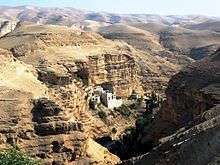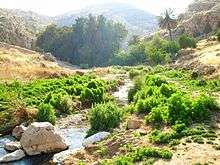Wadi Qelt
Wadi Qelt (Arabic: وادي القلط; Qelt is also spelled Qilt and Kelt, sometimes with the Arabic article, el- or al-), in Hebrew Nahal Prat (Hebrew: נחל פרת), formerly Naḥal Faran (Pharan brook), is a valley, riverine gulch or stream (Arabic: وادي wādī, "wadi"; Hebrew: נחל, "nahal") in the West Bank, originating near Jerusalem and running into the Jordan River near Jericho, shortly before it flows into the Dead Sea.



Wadi Qelt is home to a unique variety of flora and fauna. St. George's Monastery and the royal winter palace complex built by the Hasmoneans and Herod the Great are located in the Wadi, which has been identified with the biblical Perath mentioned in Jeremiah 13:5.[1]
Geography
The stream flowing eastwards down the valley that cuts through the limestone of the Judean Mountains, has three perennial springs, each with an Arabic and Hebrew name: Ein Farah/En Prat, the largest one; 'Ayn Fawar/En Mabo'a; and the single-named Qelt spring.[2]
In Hebrew the entire stream is called Prat; in Arabic though, each sections has its own name: Wadi Fara for the upper section, Wadi Fawar for the middle one, and Wadi Qelt for the lower section.[2]
Biblical relevance
The stream Chorath or Cherath, mentioned in 1 Kings 17:3 as one of the hiding places of the prophet Elijah, has been identified by some with Wadi Kelt at St. George's Monastery.[3]
A tradition holds that the parents of the Virgin Mary have prayed in Wadi Qelt to be blessed with a child. A Cave of St Anne, inhabited by hermits until a few decades ago, is connected to this tradition.
History
Bronze Age and Iron Age
Qubur Bani Isra'in are very large Bronze-Age stone structures, which rise from a rocky plateau overlooking Wadi Qelt.[4]
Hellenistic and Roman periods
Several aqueducts have been found along the stream, the oldest dating to the Hasmonean period (2nd century BCE).[2] The aqueducts transported water from three main springs, down to the plain of Jericho.[5]
The winter palaces of Hasmonean kings and Herod the Great stood at the lower end of the valley, where it reaches the Plain of Jericho.[6] A structure within the Hasmonean royal winter palace, identified by its excavator, Ehud Netzer, as a synagogue, is now known as the Wadi Qelt Synagogue, is believed to be one of the oldest synagogues in the world--[7][8] although its identification as a synagogue is contested by many scholars.
During the First Jewish war with Rome, insurgent leader Simon bar Giora is said to have held out in caves in this valley, known formerly as the Pharan brook.[9]
Late Roman and Byzantine monasticism
Wadi Qelt contains monasteries and old Christian locations.[2] According to tradition, the first monastic settlement of the Judaean desert, the Pharan lavra, was established by St Chariton the Confessor towards the end of the 3rd century in upper Wadi Qelt,[10] an area known to the Greek Orthodox as Pharan Valley.
The Monastery of Saint George was founded by John of Thebes around 480 AD, and it became an important spiritual centre in the sixth century under Saint George of Choziba. Hermits living in caves in nearby cliffs would meet in the monastery for a weekly mass and communal meal.[11]
Another Byzantine monastery was excavated at the site known in Arabic as Khan Saliba.[12] Its meager remains are located left at the left side of the T-junction of the road connecting the modern Highway 1 with the old road down the Ascent of Adummim (going to the right one reaches Jericho in the plain below.)[12] The 5th-century Monastery of St Adam was built there "for there he stayed and wept at losing Paradise" (Epiphanius).[12] Archaeologists found fine Byzantine mosaics at the former pilgrimage site.[13][14]
1967 and after
The area was occupied by Israel in 1967.
On December 20, 1968, Israeli lieutenant-Colonel Zvi (Tzvika) Ofer, commander of the elite Haruv unit, former Military Governor of Nablus and recipient of the Israeli medal of valour, was killed in action in Wadi Qelt while pursuing Arab militants who had crossed the Jordan.[15]
Tourism
Israel declared parts of the wadi as a protected area under the name Ein Prat Nature Reserve.[16]
Much of Wadi Qelt is a popular route for Palestinian and Israeli hikers. It is possible to hike all the way from the town of Hizma to Jericho, a journey of 25 kilometres and an 850m descent.[17]
Israeli, Palestinian and foreign hikers use the partially marked paths along the wadi. Palestinians are generally able to visit when coming from Nablus, Ramallah and Jerusalem without having to pass through checkpoints.
Bedouin
The wadi is used by many Bedouin shepherds. Some Bedouin and residents of Jericho are also earning their livelihood near the Monastery of St George, by offering donkey rides to pilgrims and selling them beverages and souvenirs.[18][19][20]
See also
- Chariton the Confessor, 3rd-century founder of a lavra-type monastery in Pharan Valley (upper Wadi Qelt)
- Jordan Valley
References
- "Wadi Qilt". bibleplaces.com.
- "En Prat Nature Reserve". allaboutjerusalem.com.
- "The Life Of John The Elder And The Cave Of Sapsas". St. Luke the Evangelist Greek Orthodox Church. Retrieved 9 July 2016.
- "The Tombs of the Children of Israel". goisrael.com.
- Gruber, Angela (3 April 2015). "In the occupied West Bank, even hiking is political". +972 mag. Retrieved 2 March 2016.
- "Jericho - The Winter Palace of King Herod - Jewish Virtual Library". jewishvirtuallibrary.org.
- Oldest Synagogue Found in Israel, March 29, 1998. Associated Press
- Israel's Oldest Synagogue, Archaeology, Volume 51 Number 4, July/August 1998, Spencer P.M. Harrington
- Samuel Klein, The Twenty-four City Councils in Judea (ארבע ועשרים בולאות שביהודה), Vienna 1933, p. 293 (in memory of R. Zvi Peretz Chayot), where he cites Schick and Nestle in Zeitschrift des deutschen Palästina-Vereins (ZDPV – Journal of the German Society for Exploration of Palestine), 1911, pp. 103–ff. Cf. Josephus (Wars 4.9.4).
- Skete of Saint Chariton - Fara, Russian Orthodox Ecclesiastical Mission in Jerusalem
- Palestine & Palestinians. Beit Sahour: Alternative Tourism Group. September 2008. p. 181. ISBN 978-9950-319-01-1.
- Jerome Murphy-O'Connor (2008). The Holy Land: An Oxford Archaeological Guide from Earliest Times to 1700. Oxford Archaeological Guides. Oxford: Oxford University Press. p. 452. ISBN 978-0-19-923666-4. Retrieved 30 July 2019.
- Michael Dumper; Bruce E. Stanley, eds. (2007). Cities of the Middle East and North Africa: A Historical Encyclopedia. ABC-CLIO. p. 205. ISBN 9781576079195. Retrieved 30 July 2019.
- Prignaud, Jean (1963). "Une installation monastique byzantine au Khan Ṣaliba". Revue Biblique (1946-). Peeters Publishers. 70 (Vol. 70, No. 2 (April 1963)): 243–254. JSTOR 44091910.
- Teveth, Shabtai (1969/1970) The Cursed Blessing. The story of Israel's occupation of the West Bank. Weidenfeld & Nicolson. SBN 297 00150 7. Translated from Hebrew by Myra Bank. Page 347.
- "En Prat Nature Reserve". allaboutjerusalem.com.
- Szepesi, Stefan (2012). Walking Palestine: 25 Journeys Into The West Bank. Oxford: Signal. p. 201. ISBN 978-1-908493-61-3.
- Shem Tov Sasson, University Trip: Wadi Qelt II, Israel's Good Name, 12 February 2018, accessed 3 August 2019
- Jitka Zich, Wadi Qelt (Kelt) Hike and GuideBook: Monastery of St. George of Choziba, Israel By Foot, accessed 3 August 2019
- Donkey tours, Hantourism, accessed 3 August 2019
External links
| Wikimedia Commons has media related to Wadi Qelt. |